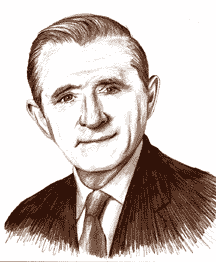INTERVIEW
Tracking The Trends Of Technical Analysis
Bob Farrell
by John Sweeney Probably no one has seen the big picture of technical analysis' growth and increasing legitimacy quite the way that Bob Farrell, a fixture at bellwether brokerage Merrill Lynch for nearly half a century, has. He seemed to be the ideal subject to summarize that growth and the winnowing out of what works and what doesn't.
Farrell is senior investment advisor of Merrill Lynch and one of Wall Street's most highly respected stock market analysts. He's seen it all and done most of it, too; he is a many-time First Teamer in the market timing category of Institutional Investor magazine's All-America Research Team. As manager of market analysis, he pioneered the use of sentiment figures using Merrill Lynch internal data. In 1993, he was inducted into the Wall $treet Week Hall of Fame. Not only that, he is a founder of the Market Technicians Association and was its first president. His Weekly Market Commentary, published since 1970 by the firm, is followed by thousands of professional money managers all over the world. In his current role as senior investment advisor, he writes quarterly on longer-term theme changes in the market.
Bob Farrell graduated from Manhattan College in 1954 with a bachelor's degree in economics and finance and received a master's degree in investment finance from the Columbia University Graduate School of Business in 1955. These days, he spends most of his time in the sunny climes of Florida, where Stocks & Commodities caught up with him in late April 2001. Interim Editor John Sweeney conducted the interview via phone.
What's the difference between now and when you first started out in this business in terms of how people think about technical analysis and how they use it?
I guess I would start with the early 1960s. I actually started in 1957 with Merrill Lynch. I got into market analysis more by luck than by design. As a trainee in research at Merrill Lynch in the late 1950s, I was offered the job of technician because no one else wanted it. I had been trained at Columbia Business School, where Benjamin Graham and David Dodd [founders of modern company analysis] were teaching, and I thought I would become a security analyst.
But you didn't.
No. I soon realized that there was more to stock price analysis than balance sheets and profit and loss statements. I quickly grasped the importance of people to the equation and that my strengths were right-brained and intuitive more than quantitative.
Fortunately, I also had a mentor who gave me an education in the markets. Bill Dunkak was the former partner in charge of research at the time, and around 1959 he decided to devote his efforts to doing more research on the functioning of the markets. He asked me to assist him while I was learning technical analysis and he initiated studies of investor behavior using Merrill Lynch's excellent sample of aggregate customer transactions. We examined patterns in margin trading, margin calls, stop-loss orders, limit vs. market orders, short sales, and so forth.
He also had a friend, Sandy Landfield, who was the partner in charge of floor positions for Carlyle Decoppet, the New York Stock Exchange (NYSE) odd-lot specialist. I would go to lunch with them and listen to their discussions of public behavior in past markets in the 1920s and 1930s and later, and I could see the basis for using public behavior as a contrary indicator. We went on to label these studies as "sentiment indicators," a term that is common in technical analysis today.
And you were in it at the start! Who was the biggest name in technical analysis back then?
I think the technician who got the greatest publicity and attention at that time was Joe Granville. I guess 1956 is when he started into the business. And by 1960 or 1961 he had written a book, A Daily Strategy For Stock Market Timing And Profit.
I remember going to hear Joe speak in 1961. He had only been in the business a year or two longer than I had. He was a lot more precocious, though, and had a lot of interesting ideas. But I think the regard for technical analysis was fairly low, relatively. People looked at it as a tool for short-term trading. There were a few giants around like Edson Gould, who did long-term work, but they were not getting the publicity that they deserved at the time.
What did you learn first in technical analysis?
At first, my evolution in the business was to work with the retail salesmen and guide them in trading. Then I realized it was more important to establish a professional reputation with institutional investors, because by the mid-1960s institutions were beginning to dominate and become the greater force in the markets. In order to do that, I had to convince the institutional investors I met that technical analysis was useful on a long-term trend basis as well as a short-term trading basis.
Good thing to point out.
In fact, that was one of the things I tried to emphasize. That took some time, but in the late 1960s and early 1970s technical analysis began to get more notice. That was when we got together to form the Market Technicians Association. Before that, there were loose-knit groups of technicians who would get together on a periodic basis to talk about the stocks they liked. We called it the Tip and Clip Club, because you suspected the guy who was telling you his favorite stock was already ready to sell it.
...Continued in the July 2001 issue of Technical Analysis of STOCKS & COMMODITIES
Excerpted from an article originally published in the July 2001 issue of Technical Analysis of STOCKS & COMMODITIES magazine. All rights reserved. © Copyright 2001, Technical Analysis, Inc.
Return to July 2001 Contents
